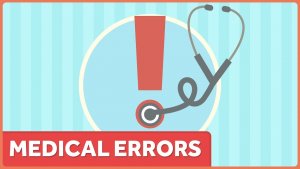
In the United States, up to 100,000 people die each year due to medical errors. In order to provide safe care, it is important for the healthcare team to integrate evidence-based practice and individualize patient care according to their specific needs. There are different types of medical errors such as diagnostic, treatment and preventative. In 86% of cases, nurses have caught the error made by physicians or pharmacists (Korhan, DIlemek, Mercan & Yilmaz, 2017). A “near miss” is when an intervention is interrupted before it results in patient injury or illness, which would then be considered a medical error.
Common causes of medical errors:
- Poor working conditions
- Tiredness of the healthcare worker
- Amount of patients being cared for by one person
- Lack of education on identifying medical errors
It is not only the healthcare professionals that make medical errors.
The patients may sometimes have a role in it as well. For example, if the patient is non-compliant or does not follow instructions carefully, problems could occur. Technology can also affect patient care. The healthcare professionals should be properly trained on the equipment they will be using in their workplace so that it is properly used. They should also know the manual way of doing things so that if the equipment is not working, work flow can still run smoothly.
Hospitals suggest that the attending physician involved in the medical error should be the one to report the incident to the patient or the patient’s family. Additional personnel who should be present in the conversation are the nurses, social workers and risk management team. Timing is very important. It should be addressed within 24 hours of realizing the error occurred (Okafor et al., (2015). It should be sooner if there is a change in the patient’s condition or if the patient and family ask questions regarding why something “does not seem right.”
It is important to remember that there are ways to prevent these errors, as well as ways to identify when one occurs so that the patient can be monitored and they remain safe during the rest of their care.
Michael Armstrong
Michael Armstrong is a past chairman of the board of trustees of John Hopkins Medicine. He told his story about a medical error that he experienced and could be considered a “near miss.” He received a call from his physician explaining that his blood count results given to him a year before were misread and it shows that he has leukemia. Soon after the diagnosis and chemotherapy treatments, he developed sepsis in his blood, but he survived. This “near miss” is what motivated him to be an advocate for patient safety and healthcare quality improvement.
References
Korhan, E. A., Dilemek, H., Mercan, S., & Yilmaz, D.U. (2017). Determination of attitudes of nurses in medical errors and related factors. International Journal of Caring Sciences, 10(2), 794–801. Retrieved from http://library.neit.edu:2048/login?url=http://search.ebscohost.com/login.aspx?direct=true&db=ccm&AN=124801498&site=ehost-live
Okafor, N. G., Doshi, P. B., Miller, S. K., McCarthy, J. J., Hoot, N. R., Darger, B. F., … Chathampally, Y. G. (2015). Voluntary Medical incident reporting tool to improve physician reporting of medical errors in an Emergency Department. Western Journal of Emergency Medicine: Integrating Emergency Care with Population Health, 16(7), 1073–1078. https://doi.org/10.5811/westjem.2015.8.27390
